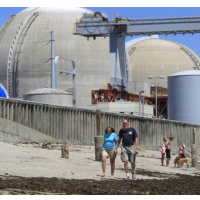Money to Decommission San Onofre Nuclear Plant Used Instead to Store Waste on Site
 San Onofre Nuclear Power Generating Station (photo: Orange County Register)
San Onofre Nuclear Power Generating Station (photo: Orange County Register)
The federal government requires that owners of nuclear power plants put money away to pay for when they are decommissioned. It's expensive to tear down a facility like that and clean up the site's contaminated areas.
But AP reported over the weekend that already-shuttered plants, like the San Onofre Nuclear Generating Station between San Diego and Los Angeles, have been dipping into those funds, with the government's blessing, to pay for storing on site the spent fuel the feds failed to take off their hands as promised.
The U.S. Nuclear Regulatory Commission (NRC) reviews and certifies the licensees every two years “to assure that decommissioning of all licensed facilities will be accomplished in a safe and timely manner and that adequate licensee funds will be available for this purpose.” In other words, the NRC wants to make sure they are putting the money away in a timely fashion.
Last month, the Office of Nuclear Reactor Regulation reported that 101 out of 104 licensed facilities (pdf)—three Illinois reactors came up short—met the funding requirements.
But in an email to Associated Press, NRC spokesman Neil Sheehan wrote, “All of the plants that have permanently shut down in recent years have sought, and been approved for, the use of decommissioning funds for spent fuel storage costs.” That includes San Onofre.
AP said the commission had to grant an exemption to rules about plant operators using money from the critical trust funds to pay for anything other than decommissioning, but did it every time they were asked.
That’s easier than making good on the nation’s promise to find a relatively safe, permanent home for highly radioactive spent fuel that is being stashed around the country under questionable conditions.
The federal government argued for decades over building a national facility for disposing of nuclear waste. Most recently, Democrats in the Senate and White House have blocked congressional Republicans from establishing Yucca Mountain, 100 miles from Las Vegas, as a national nuclear waste site.
In light of the seemingly endless delay, Southern California Edison proposed moving 2,700 spent fuel assemblies at San Onofre from highly vulnerable above-ground pools to steel canisters, wrapped in concrete, topped with steel and more concrete, and buried beneath the bluffs by the ocean. The waste would lay 125 feet from a seawall and be dangerously radioactive for thousands of years.
Earlier in the month, the California Coastal Commission approved what one critic called “America’s largest beach-front nuclear waste dump.” The commission only approved storage until 2035. By then, Edison is expected to have better options. If they don’t, they can build new containers and transfer the material at a cost (to taxpayers, no doubt) of hundreds of millions of dollars.
San Onofre closed in 2012 after a small leak of radioactive steam was discovered. Subsequent testing found hundreds of eroded steam tubes, damaged by vibration caused by new steam generators. Edison blamed manufacturer Mitsubishi, which blamed computer problems and bad math for the misdesigned equipment. There is evidence that both knew the design was problematic.
Opposition to the nuclear plant, some of it stretching back to before it first opened in 1968, coalesced around the fiasco and when it became clear that Edison was not going to be able to restart the plant without a comprehensive NRC safety review, they shut it down.
–Ken Broder
To Learn More:
Closed Nuclear Plants, Including San Onofre, Dip Into Dismantling Funds to Pay for Waste (by Dave Gram, Associated Press)
Coastal Commission OKs Seaside Storage of Spent San Onofre Nuclear Fuel (by Ken Broder, AllGov California)
Summary Findings Resulting from Staff Review of the 2015 Decommissioning Funding Status Reports for Operating Power Reactor Licensees (Office Nuclear Reactor Regulation) (pdf)
- Top Stories
- Controversies
- Where is the Money Going?
- California and the Nation
- Appointments and Resignations
- Unusual News
- Latest News
- California Forbids U.S. Immigration Agents from Pretending to be Police
- California Lawmakers Urged to Strip “Self-Dealing” Tax Board of Its Duties
- Big Oil’s Grip on California
- Santa Cruz Police See Homeland Security Betrayal in Use of Gang Roundup as Cover for Immigration Raid
- Oil Companies Face Deadline to Stop Polluting California Groundwater





